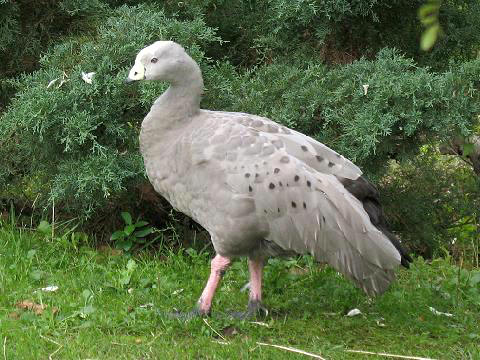| 새로운 사진 | 신문속의 동물소식 | 신기한 동물이야기 | 동물의 소리 | 동물동화상 | 사진 올리기 | 사진 저작권 | English |
|---|
| 재미있는 동물사진 | 괴수/괴어/엽기 동물사진 | 동물이름사전 | 동물목록 | 바깥고리 | 창고입구 | 똑똑누리집 |
|---|
| 이미지 정보 | Original File Name: Stavenn_Cape Barren Goose (Cereopsis novaehollandiae)_00.jpg Resolution: 480x360 File Size: 55579 Bytes Upload Time: 2008:01:06 22:51:13 | |
| 올린이 | 이름 (메일주소): Unknown | |
| 사진 제목 | Cape Barren Goose (Cereopsis novaehollandiae) - Wiki | |
 |
| Email : 카드 | 올린이 | 운영자 사진삭제 정보수정 Admin |
| 설명 | Cape Barren Goose (Cereopsis novaehollandiae) - Wiki
Cape Barren Goose
The Cape Barren Goose, Cereopsis novaehollandiae is a large goose resident in southern Australia. It is a most peculiar goose of uncertain affiliations (Sraml et al. 1996). It may either belong into the "true geese" and swan subfamily Anserinae or into the shelduck subfamily Tadorninae as distinct tribe Cereopsini, or be separated, possibly including the prehistorically extinct flightless New Zealand Geese of the genus Cnemiornis, in a distinct subfamily Cereopsinae. Indeed, the first bones of the New Zealand birds to be discovered were similar enough to those of the Cape Barren Goose to erroneously refer to them as "New Zealand Cape Barren Goose" ("Cereopsis" novaezeelandiae). These are bulky geese and their almost uniformly grey plumage, bearing rounded black spots, is unique. The tail and flight feathers are blackish and the legs are pink with black feet. The short, decurved black bill and green cere gives it a very peculiar expression. The Cape Barren Goose is 75-100 cm (30-40 in) long, and has a 150-190 cm (59-75 in) wingspan; males are somewhat larger than females. The male weighs on average 5.29 kg (11.6 lbs) and the female 3.77 kg (8.3 lbs). This bird feeds by grazing and rarely swims. It is gregarious outside the breeding season, when it wanders more widely, forming small flocks. A previous decline in numbers appears to have been reversed as birds in the east at least have adapted to feeding on agricultural land. The breeding areas are grassy islands off the Australian coast, where this species nests on the ground in colonies. It bears captivity well, quite readily breeding in confinement if large enough paddocks are provided. In Australia, 19th century explorers named a number of islands "Goose Island" due to the species' presence there. http://en.wikipedia.org/wiki/Cape_Barren_Goose
| |||
| 저작권 정보 | 사진의 저작권은 원저작자에게 있습니다. 동물그림창고는 동물관련 사진을 전시할 수 있는 공간만을 제공합니다.사진을 사용하고자 할 경우에는 저작권자와 협의하시기 바랍니다. |
|
|
|
| |||||||
| CopyLeft © since 1995, 동물그림창고. All rights may be reserved. | ||||||||
Stats